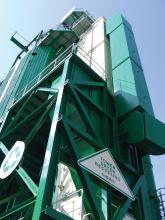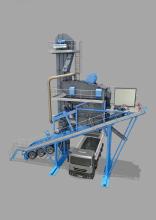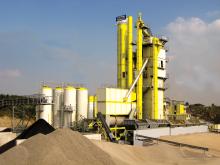
New demands from operators mean that asphalt plant manufacturers have had to come up with new solutions.
This has been brought about because of a greater emphasis on higher productivity with lower costs; warm asphalt mixes; an increasing awareness of environmental issues, and a rise in the use of recycled material. One innovative concept, ConAsphalt, is being put forward by
Under conventional means, a contractor would need two different types of production plants to produce the two different materials needed for the project but the aim of ConAsphalt is to change that.
Where the jobsite is not in delivery range of a stationary facility such as an asphalt or concrete plant, being able to produce all the materials for a project would be advantageous for the contractor who would be able to bid for both parts of the contract and self-perform, realising a stronger financial outcome of the job.
In order to provide production of mixed materials, Astec took a closer look at the structural components of aggregate with a binder, such as asphalt cement for making hot-mix asphalt (HMA) or Portland cement for making concrete, and found that both materials have a similar constituent make-up: the variable is the addition of either asphalt cement or Portland cement (with water or other additives) to create the desired mix. Most concrete for road building is produced in a plant with a mixer, either a tilt-drum mixer or a twin-shaft mixer. Every asphalt and concrete plant has components that help proportion the materials, including the sand.
Astec said, "The ConAsphalt plant would manage the production of both asphalt and concrete with the same group of aggregate bins. The contractor would then improve the profitability and consistency of the materials by using fractioned aggregates for concrete or asphalt in the multi-bin aggregate management system. The single plant would have the mechanical devices to make either product simply by engaging the right controls to move the aggregates to the appropriate mixer."
Recycling
Turkish company
Another key feature of the system is the triangular profile dryer where the RAP is heated indirectly and which is conveyed cold in a vertical elevator to prevent sticking and build-ups. Hot material in the system flows from top to bottom, and heat loss is prevented because the RAP is stored in a heated bin.
The RATech can also be incorporated with conventional asphalt batching plants to produce the higher quality binder and wearing course grades of asphalt.
Another manufacturer,
Mixing is carried out in the chamber at optimum temperatures to ensure a homogenous product. "The bitumen in the RAP does not burn as the flame does not touch the material," explained the company.
The new dryer ensures an effective coating process and because it uses RAP (which already contains bitumen) it offers substantial savings on bitumen costs.
Carbon issues
According to the
"There are various available methods for producing low-temperature asphalt including the use of additives or special binding agents as well as using foamed bitumen and modified mixing cycles. It is also possible to combine these methods. It is usually possible to lower the asphalt temperature by at least 20°C and sometimes by as much as 70°C or more." The company said the use of foamed bitumen is one method for reducing temperatures as it is easy to mix with hot aggregate.
"The basic principle behind the production of foamed bitumen is as simple as it is ingenious: cold water is injected into the flowing mass of 150°C bitumen. The water is immediately heated above boiling point and evaporates in part. The result is a mix of steam, water and bitumen. This mix is injected into the asphalt mixer. The use of foamed bitumen allows the temperature of the aggregate, and therefore that of the asphalt, to be reduced by approximately 60°C with no loss of quality." Late in 2010, the Hans Weibel company laid 1,500tonnes of low-temperature asphalt on a busy road near Koppigen in the Swiss region of Emmental, with the asphalt being produced 40km away in Oberwangen using an Ammann Universal NG 320 asphalt mixing plant.
"The advantages of using the new kind of asphalt became apparent as soon as installation started: it reached the construction site at a temperature of around 110°C and was compacted at temperatures below 80°C," said Ammann.
Another warm mix system comes from
Hot liquid asphalt and water combine inside the expansion chamber, and the foamed asphalt is immediately injected into the drum to evenly and thoroughly coat heated aggregate (the system can produce up to 544tonnes per hour of asphalt at a 4% injection rate).
With these development just being the main highlights of innovation in asphalt technology, it is clear that equipment producers are proactively working to help lower the carbon footprint of road construction.
Marini renews old plant
When the Adige Bitumi Group decided to renew its old M 260 asphalt plant it collaborated with Italian company Marini to design and develop a plant with production of 280 to 300tonnes per hour for its site in Mezzocorona, northern Italy. According to Marini (part of the
The plant was designed with a high number of pre-dosing units (12 for aggregates, plus three for the pre-processed and selected milled material) to guarantee maximum precision in dosages and operational elasticity.
"Thanks to the advantages of the drying tower with the bag filter and the storage silo for the fine products located directly above the drying drum, the Marini Top Tower 4000 limits not only the ground dimensions, but guarantees optimisation of the heat energy balance and also the recovery of energy radiated from the drum," said Marini.
A six-selection screening unit was chosen for the mixing tower (in the completely covered version with significant reduction of noise and heat loss), and this offers ease of screen replacement and maintenance.
"Significant care was also given to reducing noise and atmospheric emissions and from this point of view the coverings of the mixing tower and the finished product storage silo (with a high storage capacity of finished product of over 400tonnes) were realised," said Marini.










